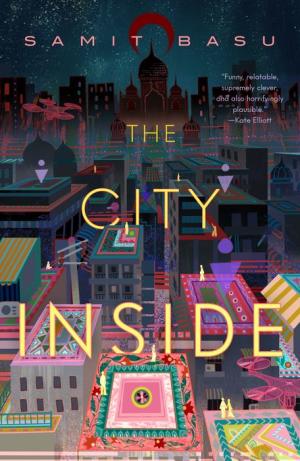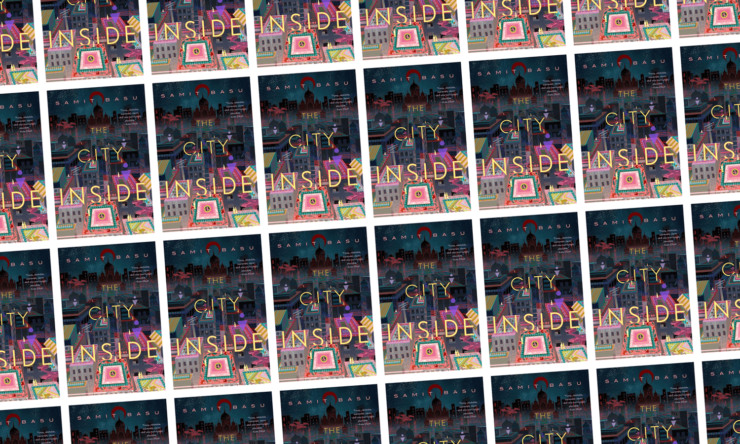The best spec fic/cyberpunk writing is often less wikipedian and more of a wave—an artful sprinkling of jargon and worldbuilding that’s just familiar enough for a reader to recognize the near-future rhythm of a different reality. It’s less about constant, flat exposition and more about the right vibes to hint at what flavor of -topia we’re dealing with. In the case of The City Inside, it’s everything everywhere all at once, treading both familiar speculative ground, yet somehow making the topics that fuel our present-day paranoia—omniscient apps, social media as a service, the disintegrating borders between flesh and digital—fresh and new.
Samit Basu’s latest novel is a masterclass in smart, human-driven science fiction, told with delectable wit and gorgeous, visually-driven prose. He does an effortless job at leading the reader by the nose through an extrapolated, tech-gilded version of New Delhi—one based from existing social and political forces that endanger India’s most vulnerable and marginalized populations including dalits and Muslims.
The story follows a loose ensemble cast that orbits around Joey Roy, a talented “Reality Controller” for a popular Flowstar named Indi. Flowstars are influencers on steroids—Flows are like an unholy hybrid of livestreamed reality shows and TikTok, fusing the semi-scripted consistency of the former with the careful edits, performativity, and viral potency of the latter. There’s Rudra Gupta, a poor little rich boy estranged from his powerful family, who prefers to live online like a borderline hikikomori, at least until he gets sucked into Joey’s cutthroat world of Flowcos, fans, and funders. Indi, who also happens to be Joey’s ex, is an alarmingly on-the-nose amalgam of familiar names and faces (Hasanabi kept popping up in my head) for people who are terminally online; he’s also India’s biggest Flowstar. There are girlfriend-types, Flow rivals, concerned parents, noxious billionaires, and unlikely revolutionaries—a maelstrom of personas and personalities that live in carefully edited parallel realities.
Buy the Book


The City Inside
Through slice-of-life snapshots of the main characters going about their business, Basu crafts a magnetic look at the behind-the-scenes tension of India’s biggest Flow, as Joey tries to stay on top of her game. As Rudra and Joey’s realms converge with spectacularly chaotic results, it’s clear that there’s much more going on than your garden variety pop culture drama—there are deeper and more troubling things happening with the worst of invasive biotech: constant surveillance, constant avatar companionship, and “smartatts.” As one character observes, mainstream Indian culture flows from the top—a dynamic that has long defined the world’s biggest democracy, where change is at best glacial, and at worst cosmetic. Set agains the backdrop of Indi’s Flow operation, characters come to critical personal epiphanies while keeping up appearances to survive.
The City Inside is at once a traditional linear examination of social and political awakening; a simmering call to action that tugs at Joey and Rudra’s respective consciences. Basu’s multilayered New Delhi—an endless onion of caste politics, feckless celebrity shenanigans, guerilla activism, and the unpredictable seethe and roil of its everyday people—is at once chaotic and instantly recognizable. The more pedagogical narrative elements reminded me of Neal Stephenson’s The Diamond Age (arguably his favorite work of mine) which used allegories and fairytales to structure both a cyberpunk bildungsroman and a sort of comedy of manners. And while Joey and Rudra aren’t children, Basu adapts similar principles, albeit in a Minecraft-style setting, to explore ideas of solidarity and slow revolution with great effect.
Most significantly, Basu refuses to succumb to the easy trap of “big AI gone wrong” and consciously chooses to stick to a human-centric narrative. Joey’s secret recipe is actually quite simple—unlike other Flowco producers, she runs a hands-on ship that prioritizes direct physical observations and analyses over algorithms and remote controls. There’s no wonder, then, that Indi is such a consistently watchable star. He’s the most engaged and fluidly responsive Flowstar of the lot, and one step away from attaining “Icon” status. There’s no sinister sentient robot waiting behind the scenes, only the withering, disappointing certainty of human error, tech-driven avarice, and (something that Basu does admirably well at) the lies and half-truths we tell ourselves to lessen the weight of our own complicity. The character of Tara is particularly recognizable here as the sort of Fun Fearless Futurist Feminist that defines so much online discourse without actually evoking meaningful change, and it’s painfully ironic to see these sorts of characters complain about others failing upward.
There’s also the ongoing extreme climate change as Joey (and the rest of the population who can afford it) trudges through ruinously hot, dusty days donning a smog mask and full-body gear. Basu’s world is a dangerously real extension of our current, ongoing crisis, which will inevitably hit the Global South the hardest. He touches on the hypocrisies of the west without diving into pedantry or pageantry—his sharp observations are known phenomena and problems, weaved seamlessly into the narrative. But perhaps most grim is his reminder that The City Inside isn’t set in a dystopia, but a best-case scenario.
There’s also a devastating scene where one character delivers a simple truth that mainstream science fiction discourse refuses to acknowledge. “Dystopia is pornographic,” she snaps. “You see it and shiver but it’s also kind of fun because it’s happening somewhere else, to someone else… some of us are actually sitting in the fucking middle of it and we may never learn to care in time. This isn’t dystopia. This is reality.” In this one breath, Basu captures the essence of what frustrates me most about sci-fi flavored discourse about futurism, especially when it comes to discussions about genre and marketability. Through his sublime prose, he also contextualizes inherently Indian concepts into the universal tropes and language of speculative fiction, all without falling into its worst pitfalls and nihilism. The City Inside is a reckoning, but for me, it was much more—a righteous retooling of cyberpunk sensibilities and principles that actually provoke emotion and reaction, an unthinkably powerful feat in an age where cyberpunk (at least how we know and recognize it) needs to die.
The City Inside is available from Tordotcom Publishing.
Alexis Ong is a freelance culture journalist with weak ankles who mainly writes about games, tech, and pop culture. Her work has appeared in The Verge, Polygon, Kotaku, Rock Paper Shotgun, VICE, Dazed Digital, and more; soft spots include science fiction, internet archaeology, comics, boxing, and old games. You can find her at her website or on Twitter.










